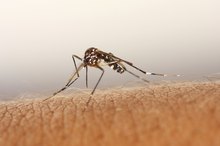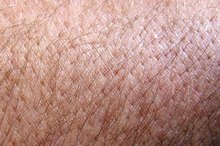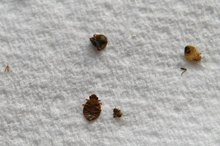Which Insect Bites Cause Blisters?
Many insects cause blisters, but many blisters are so tiny that you experience them as just little bumps. However, some insects and spiders produce distinct and often very large blisters. In the United States, the bites of the brown recluse spider, the yellow sac spider and fire ants cause characteristic blisters. Handling of blister beetles also causes eruption of blisters on the skin. The blister-causing bites of these insects and arachnids are not life-threatening except in cases of hypersensitive individuals, who may have a severe allergic reaction to the venom or toxin.
Brown Recluse Spider
The brown recluse spider, native to the United States, is found in Midwestern and Southern states. You can identify the spider by the dark violin marking on its back. It is less than one half inch long. The spider likes to hang out in undisturbed dark indoor and outdoor places. It is not aggressive, but will bite if disturbed. When you get bitten, you may not feel the bite, but after two to eight hours, a small blister appears, surrounded by a red swollen area. The swollen area may become bluish-grey and enlarge to almost 3 inches. The bite from a brown recluse spider may take a long time to heal 1.
- The brown recluse spider, native to the United States, is found in Midwestern and Southern states.
- You can identify the spider by the dark violin marking on its back.
Yellow Sac Spider
Common Spiders in Nevada
Learn More
Yellow sac spiders live outside and inside homes. They account for most spider bites, but bites are often misdiagnosed by health care providers as brown recluse spider bites, according to the Michigan State University Extension 1. They are small spiders, 1/8 to 3/8 inches long with a light yellow or beige body. The spiders usually hide by day and come out at night.
They bite when they become trapped between human skin and clothing or bed sheets. People often get bitten while gardening. The bite is usually painful; a blister will develop one to 10 hours later. The blister and redness is generally less severe than that produced by the brown recluse spider.
- Yellow sac spiders live outside and inside homes.
- The spiders usually hide by day and come out at night.
Fire Ants
Fire ants are 1/8 to 1/4-inch long and reddish-brown. They originated in South America, but now have spread and are prevalent in the southern part of the United States. Fire ants build large mounds in sunny locations in fields and gardens. When coming in contact with people or animals, they will attack, biting the skin repeatedly.
The sting of these ants is very painful and will itch before forming blisters. Although deaths are rare from fire ant bites, some people are allergic to the fire ant's venom.
- Fire ants are 1/8 to 1/4-inch long and reddish-brown.
- The sting of these ants is very painful and will itch before forming blisters.
Blister Beetle
Poisonous Wood Spiders
Learn More
Blister beetles range in length from less than half an inch to 1 inch. They have a narrow body, which can be black, grey, metallic or striped. They usually hang out in groups and feed on ornamental plants, vegetables and alfalfa. The bodies of these beetles contain a toxin, cantharadin, which causes blisters on the skin. Wear gloves when handling these beetles or crops containing live or dead beetles. Horses become very ill and may die when they eat feed contaminated with dead blister beetles.
- Blister beetles range in length from less than half an inch to 1 inch.
- The bodies of these beetles contain a toxin, cantharadin, which causes blisters on the skin.
Related Articles
References
- Ohio State University Fact Sheet: Brown Recluse Spider
- Cedars Sinai Medical Center. Brown Recluse and Black Widow Spider Bites in Children.
- Sotelo-cruz N, Gómez-rivera N. [Neurotoxic manifestations of black widow spider envenomation in paediatric patients]. Neurologia. 2016;31(4):215-22. doi:10.1016/j.nrl.2015.05.007
- Williams M, Nappe TM. Black Widow Spider Toxicity. StatPearls Publishing. Updated March 8, 2019.
- Stoecker WV, Vetter RS, Dyer JA. NOT RECLUSE-A Mnemonic Device to Avoid False Diagnoses of Brown Recluse Spider Bites. JAMA Dermatol. 2017;153(5):377-378. doi:10.1001/jamadermatol.2016.5665
- Vetter RS. The distribution of brown recluse spiders in the southeastern quadrant of the United States in relation to loxoscelism diagnoses. South Med J. 2009;102(5):518-22. doi:10.1097/SMJ.0b013e3181a0abb3
- Illinois Department of Public Health. Brown Recluse and Black Widow Spiders.
- Rahmani F, Banan Khojasteh SM, et al. Poisonous Spiders: Bites, Symptoms, and Treatment; an Educational Review. Emerg (Tehran). 2014;2(2):54-8.
- Gaver-wainwright MM, Zack RS, Foradori MJ, Lavine LC. Misdiagnosis of spider bites: bacterial associates, mechanical pathogen transfer, and hemolytic potential of venom from the hobo spider, Tegenaria agrestis (Araneae: Agelenidae). J Med Entomol. 2011;48(2):382-8. doi:10.1603/ME09224
- Livshits Z, Bernstein B, Sorkin LN, Smith SW, Hoffman RS. Wolf spider envenomation. Wilderness Environ Med. 2012;23(1):49-50. doi:10.1016/j.wem.2011.11.010
- Meires J, Louden B. Bite of the Brown Recluse Spider. Clinical Review. 2010(12):14-17.
- Pagac BB, Reiland RW, Bolesh DT, Swanson DL. Skin lesions in barracks: consider community-acquired methicillin-resistant Staphylococcus aureus infection instead of spider bites. Mil Med. 2006;171(9):830-2. doi:10.7205/milmed.171.9.830
- Mikals K, Beakes D, Banks TA. Stinging the Conscience: A Case of Severe Hymenoptera Anaphylaxis and the Need for Provider Awareness. Mil Med. 2016;181(10):e1400-e1403. doi:10.7205/MILMED-D-15-00536
- Gaver-Wainwright MM, Zack RS, Foradori MJ, Lavine LC. Misdiagnosis of spider bites: bacterial associates, mechanical pathogen transfer, and hemolytic potential of venom from the hobo spider, Tegenaria agrestis (Araneae: Agelenidae). J Med Entomol. 2011 Mar;48(2):382-8.
- Isbister GK, Framenau VW. Australian wolf spider bites (Lycosidae): clinical effects and influence of species on bite circumstances. J Toxicol Clin Toxicol. 2004;42(2):153-61.
- Livshits, Z., Bernstein, B., Sorkin, L., Smith, S., & Hoffman, R. (2012). Wolf Spider Envenomation. Wilderness & Environmental Medicine, 23(1), 49-50. doi:10.1016/j.wem.2011.11.010
- Pagac BB, Reiland RW, Bolesh DT, Swanson DL. Skin lesions in barracks: consider community-acquired methicillin-resistant Staphylococcus aureus infection instead of spider bites. Mil Med. 2006 Sep;171(9):830-2.
- Payne, K., Schilli, K., Meier, K., Rader, R., Dyer, J., & Mold, J. et al. (2014). Extreme Pain From Brown Recluse Spider Bites. JAMA Dermatology, 150(11), 1205. doi:10.1001/jamadermatol.2014.605
- Robinson, J., Kennedy, V., Doss, Y., Bastarache, L., Denny, J., & Warner, J. (2017). Defining the complex phenotype of severe systemic loxoscelism using a large electronic health record cohort. PLOS ONE, 12(4), e0174941. doi:10.1371/journal.pone.0174941
- Stoecker, W., Vetter, R., & Dyer, J. (2017). NOT RECLUSE—A Mnemonic Device to Avoid False Diagnoses of Brown Recluse Spider Bites. JAMA Dermatology. doi:10.1001/jamadermatol.2016.5665
Writer Bio
Based in Connecticut, Marie-Luise Blue writes a local gardening column and has been published in "Organic Gardening" and "Back Home." Blue has a Ph.D. in biological sciences from the State University of New York at Stony Brook and wrote scientific articles for almost 20 years before starting to write gardening articles in 2004.









